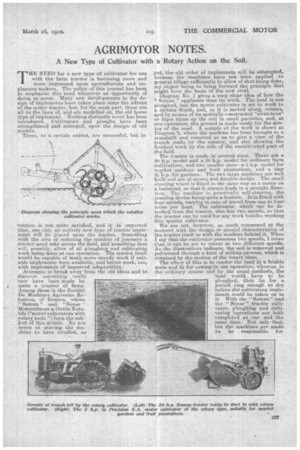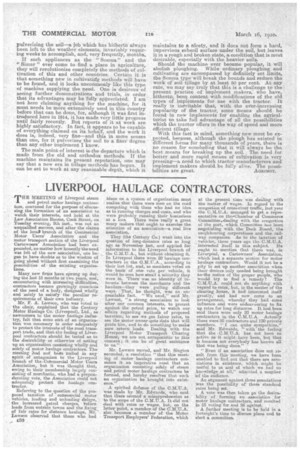• AGRIMOTOR NOTES.
Page 21

Page 22

If you've noticed an error in this article please click here to report it so we can fix it.
A New Type of Cultivator with a Rotary Action on the Soil.
THE NEED for a new type of cultivator for use with the farm tractor is becoming more and more impressed upon agriculturists and implement makers. The policy of this journal has been to emphasize this need whenever an opportunity of doing so arose. Many new developments in_ the design of implements have taken place singe the advent of the motor tractor, but, for the most part, these are all on the lines of, and are modelled on, the old horse type of implement. Nothing distinctly novel has been introduced. , Cultivators and ploughs have been strengthened and enlarged, upon the design of old models.
These, to a certain extent, are successful, but in vention is not quite satisfied, and it is expected that, one day, an entirely new type of tractor implement will be placed upon the market. Something with the idea of reducing the number of journeys a tractor need take across the field, and something that will, possibly, allow of all ploughing and cultivating
work being done at one operation. be tractor itself would be capable of much more speedy work if .suitable implements Were available, and better work, too, with implements of improved adaptability. • Attempts to break away from the old ideas and to discover something really new have been made by quite a number cif firms. Among these is the Societe De Machines Agrieoles Relatives, of Geneva' whese " Somua " and "Simar " Motoculteurs a OutilS Rotatifs ("motor cultivators with rotary tools ") form the subject of this article. No pre tenc,e at proving the machine to have rivalled, as yet, the old order of implements will be attempted, because the machines have not been applied to general tillage sufficiently to allow of that being done, my Object being to bring forward the principle that might form the basis of the new rival. Diagram No. 1 gives a very clear idea of how the " Somua " appliance does its work. The land is not ploughed, but the motor cultivator is set to work to a certain depth, and, as it is moved along, rotates, and by means of its snecially-constructed "scratchers" or tines turns up the soil in small particles, and, at one operation the ground is made ready for the sowing of the seed. A sample of the work is shown at Diagram '2, where the machine has been brought to a standstill and removed so as to give a view of the trench made by the rotator, and also showing the finished work .by the side of the uncultivated part of the field.
• The tractor is made in several sizes. There are a 20 h.p. model and a 30 h.p. model for ordinary farm cultivations, and two smaller ones—a 5 h.p.. model for market gardens and fruit plantations, and a tiny for gardens. The two large machines are well built and are of strong and durable design. The small steering wheel is fitted in the same way as a castor on a bedstead, so that it always leads in a straight direction. The machine is practically self-steering, the steering device being quite a feature. It is fittest with four speeds, varying in rate of travel from one to four miles per hour. The cultivator, which can be detached from the tractor, also has two speeds, so that the tractor can he used for any work besides working this special cultivator. We are not, however, so much concerned at the moment with the design or special characteristics of the tractor itself as with the machine behind it. When I say that the cultivator possesses two speeds, I mean that it, can be set to rotate at two different speeds. As the illustrations indicate, the soil is removed and pulverized through a kind of milling process, which is obtained by the motion of the rotary tines.
'The effect of this is to reader the land in a friable state and fit for sowing in one operation., whereas, in the ordinary course and by the usual methods, the land would have to be ploughed, then lie for a period long enough to dry before the cultiN'ating implements could be taken on to it. With the " Somua " and the " Simar " tractor cultivator, ploughing and cultivating -operations are both completed at one and the same time. Not only that, hut the machines are made to be responsible for pulverizing the soil—a job which has hitherto always been left to the weather elements, invariably requiring weeks to accomplish, and, very freqently, months..
If such appliances as the " Soinua" and the " Simar " ever come to find a place in agriculture, they will revolutionize completely the methods of cultivation of this and other countries. Certain it is that something new in cultivatirfg methods will have to be found, and it looks uncommonly like this type of machine supplying the need. One is desirous of seeing further demonstrations and trials, in order that its advantages may be 'fully appreciated. I am not here claiming anything for the machine, for it must needs be more extensively used in this country before that can be done, for, although it was first introduced here in 1914, it has made very little progress until fairly recently. But reports of it at work are highly satisfactory. -In fact, it appears to be capable of everything claimed on its behalf, and the work it does is, indeed, very fine—and this in more senses than one, for it pulverizes the soil to a finer degree than any other implement I know.
The main point of interest is.the departure which is made from the old and orthodox methods. If the machine maintains its present reputation, one may say that a new era in tillage methods has begun. It can be set to work at any reasonable depth, which it maintains to a nicety, and it does not form a hard, impervious subsoil surface under the soil, but leaves it in a rough and broken state, a condition that is most desirable, especially with the heavier soils.
Should the machine ever become popular, it will• abolish ploughing. While ordinary ploughing and cultivating are encompassed by definitely set limits, the Soutua type will break the bounds and reduce the work of soil tillage by at least 50 per cent. At any rate, we may say truly that this is a challenge to the present practice of implement makers,who have, hitherto, been content with modifications of the old types of implements for use with the tractor. It really is inevitable that, with the ev'er-increasing popularity of the tractor, some means should be found in new implements for enabling the agriculturist to take full advantage of all the possibilities which the tractor offers in the way of speed and more efficient tillage.
With this fact in mind, something new must be expected, because, although the plough has existed in different forms for many thousands of years, there is no reason for concluding that it will always be the best means for breaking up the soil. The need for better and more rapid means of cultivation is very pressing—a need to which tractor' manufacturersand implement makers should be fully alive. The possi bilities are great. AGRIMOT.


























